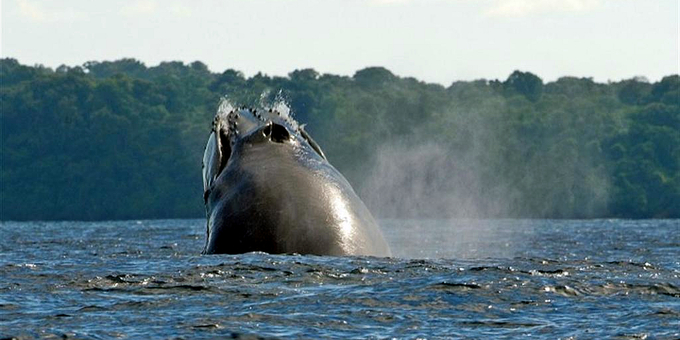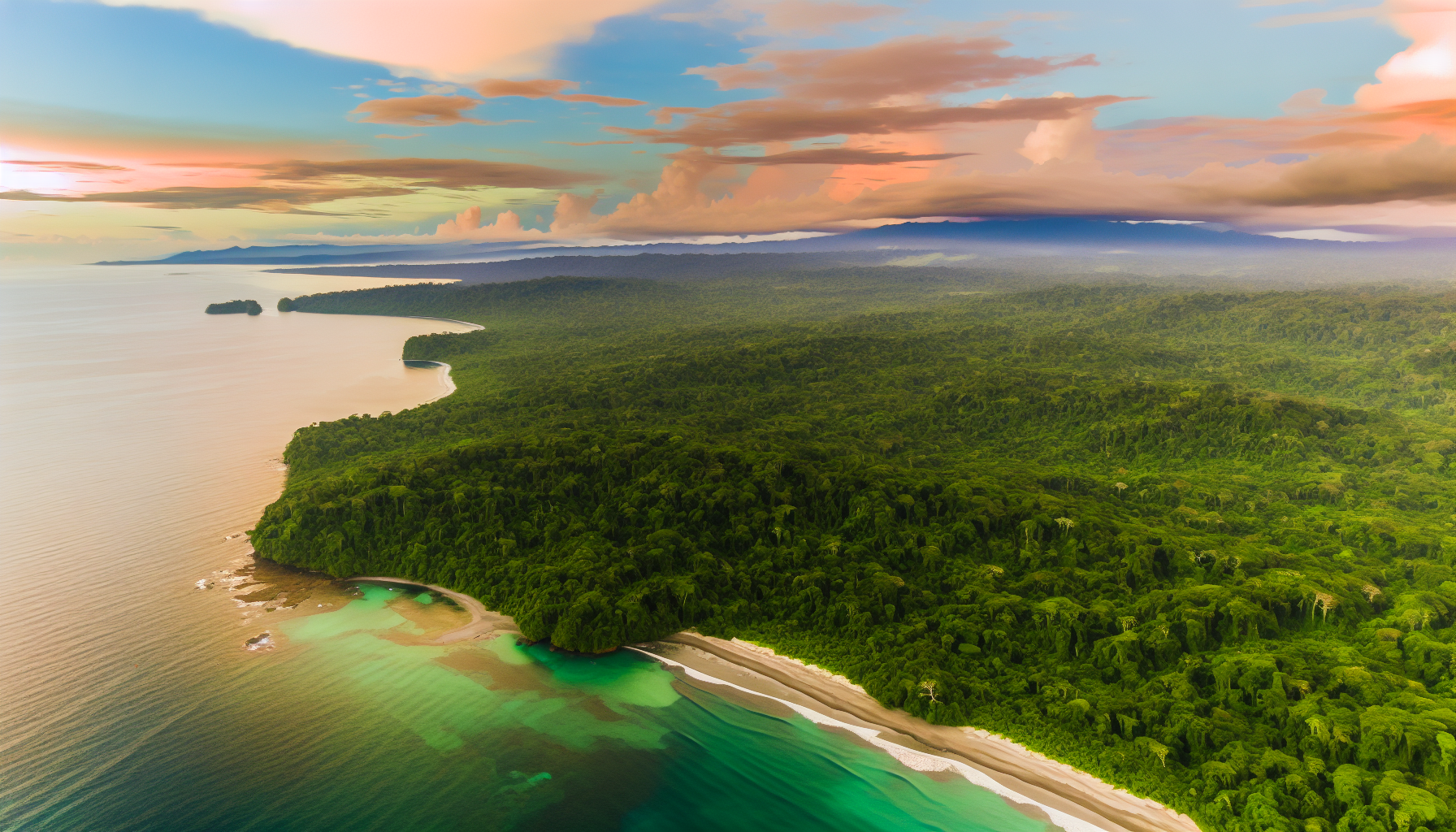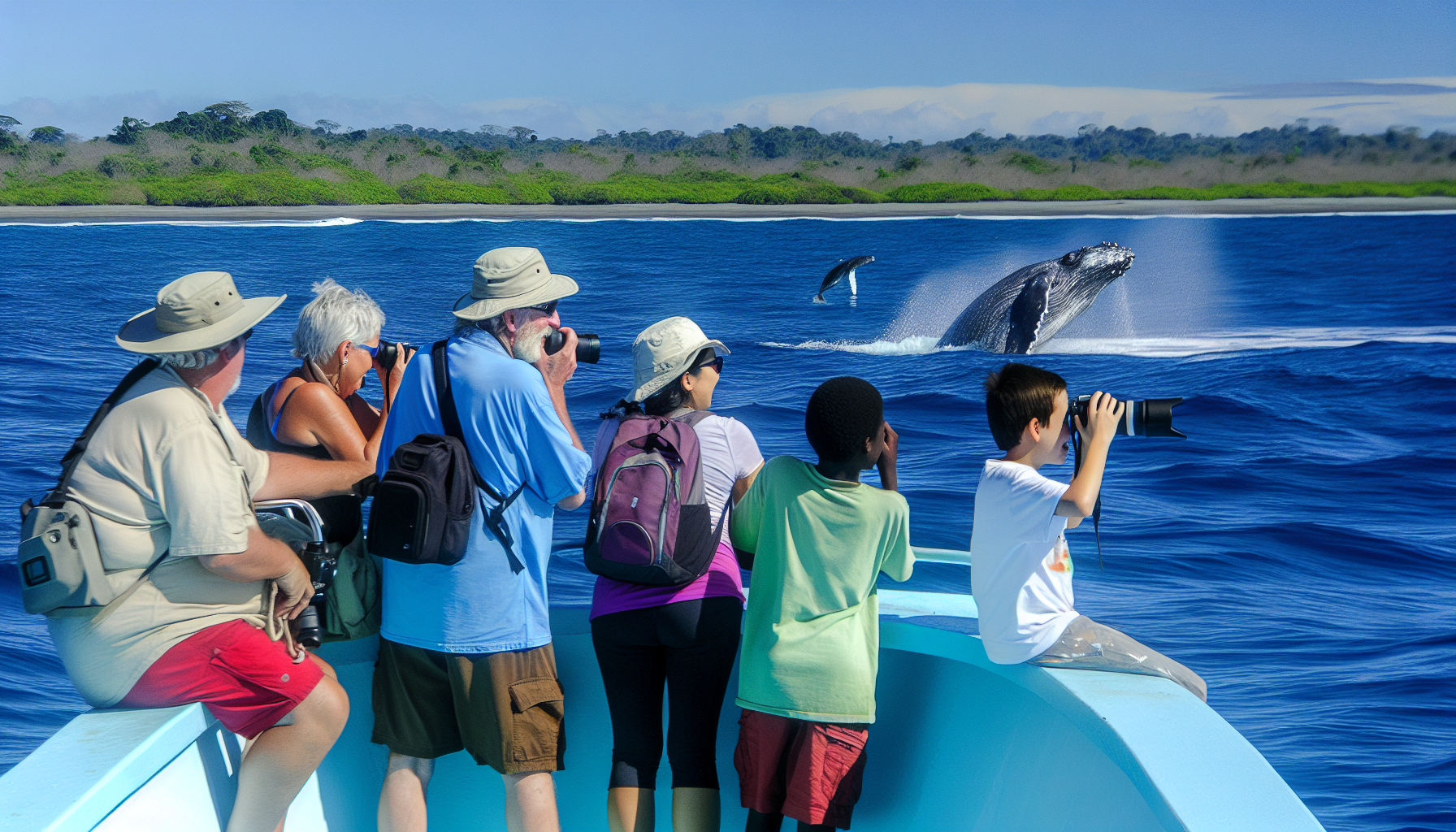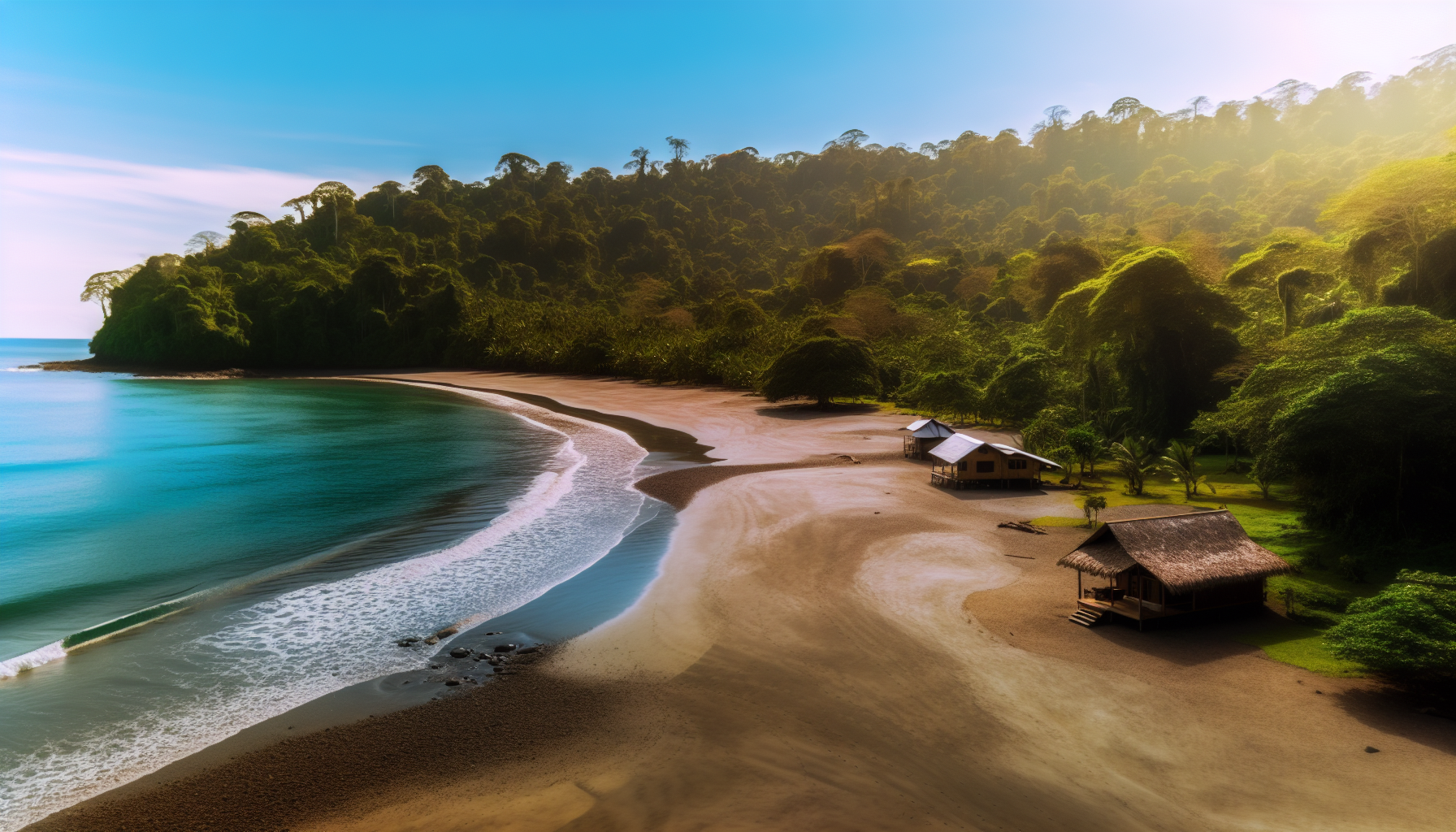
Welcome to the Osa Peninsula, Costa Rica’s hidden gem! This remote corner of Central America is a paradise for nature lovers, offering an abundance of wildlife encounters, pristine beaches, and unique eco-tourism experiences. Ready for an adventure? Let’s embark on this journey together!

The Osa Peninsula is a remote biodiversity hotspot in Costa Rica, offering unique wildlife experiences in Corcovado National Park and opportunities for snorkeling and diving near Caño Island Biological Reserve (Isla del Caño).
Transportation to the Osa is accessible with multiple options, and visitors can choose from various accommodation styles like picturesque villages, eco-lodges, and remote beach retreats.
Visitors can immerse themselves in Costa Rica’s natural beauty all year round and contribute to local conservation and ecotourism efforts by participating in environmentally friendly practices and supporting local communities.

Hidden in the heart of Central America, along Costa Rica’s Southern Pacific Coast, you’ll find the tropical paradise of the Osa Peninsula. Recognized by National Geographic as being one of the most biologically diverse places on Earth, this spectacular location teems with biodiversity and wilderness, making it an essential visit for nature lovers. From secluded beaches to lively wildlife, the Osa provides an enchanting retreat from modern life’s hustle and bustle.
Imagine walking along the stunning beaches of Drake Bay, located on the north western coast, with the sound of crashing waves echoing in your ears and scarlet macaws painting the sky with their vibrant colors. This idyllic region is where you can truly experience the charm of Costa Rica’s Osa Peninsula. The lush, tropical rainforest climate and rich biodiversity make every visit to this tropical rainforest a unique adventure.
The crown jewel of the region is Corcovado National Park, the country’s wildest and most remote national park and a sanctuary for a plethora of endangered species. From majestic jaguars to fascinating spider monkeys, the park is a testament to the natural beauty that Costa Rica encapsulates. Whether you’re an avid hiker, an enthusiastic birdwatcher, or a simple lover of nature, the Osa Peninsula is sure to leave you in awe of its untouched beauty.
The Osa Peninsula, a biologically rich area in Costa Rica, is a hidden treasure waiting to be discovered. Located on the far southwestern Pacific edge of the country, this is a remote outpost destination that requires either a flight or a long drive and often a boat ride, adding to its allure of being a secluded paradise. The region’s remoteness, combined with its impressive biodiversity, makes the Osa Peninsula Costa Rica a prime destination for eco-tourists.
The Osa hosts a wide variety of unique wildlife and plant life, exclusive to this region. Scientists estimate that 2.5 percent of the world’s biodiversity exists here, making it a truly remarkable place. The peninsula’s commitment to conservation has resulted in the survival of exotic species like:
spider monkeys
jaguars
scarlet macaws
tapirs
sea turtles
anteaters
dolphins and whales off its coast
This makes it an ideal destination for wildlife enthusiasts.
The Osa Peninsula exemplifies nature’s marvels and the significance of conservation, providing a singular experience blending adventure, relaxation, and learning. To witness this firsthand, visit this amazing area and immerse yourself in its beauty.
Corcovado National Park, located within the Osa Peninsula, is a haven for wildlife enthusiasts. The park boasts an impressive array of wildlife, including but not limited to:
Over 400 bird species
All six large feline species found in Costa Rica
The endangered Baird’s tapir
Monkeys, sloths, crocodiles, and sea turtles
The park is home to an incredible 5% of the world’s animal population and represents over 50% of all species living in Costa Rica, making it a truly remarkable destination for any nature lover.
The park’s dedication to conservation is reflected in its stringent visitor regulations. The park limits the number of daily visitors to ensure minimal environmental impact. Since 2014, all visitors are required to have a certified guide with them, enhancing the safety and quality of the experience.
For those seeking thrilling underwater adventures, the nearby Caño Island Biological Reserve offers fantastic opportunities for snorkeling and scuba diving. The waters surrounding the Osa offer world-class sport and deep-sea fishing opportunities for billfish, roosterfish, yellowfin tuna, mahi mahi, and many other species.
Preparing for your trip to the Osa Peninsula is an adventure in and of itself. Whether you’re traveling by road or by air, the journey to this tropical paradise is sure to be an unforgettable experience. From San José, scenic highways lead to this remote outpost and offer breathtaking views along the way. You may also wish to stop by Marino Ballena National Park along the way. This ocean park offers incredible whale-watching opportunities from late August through October and also from late December through February.
Puerto Jimenez serves as a great starting point for your exploration of the eastern side of the peninsula. The mostly paved roads ensure a smooth and enjoyable journey, with stunning beaches and wildlife encounters adding to the excitement.
Drake Bay is the hub for the western side of the peninsula but not as easily accessible. There are paved roads to the Sierpe River, where you can choose to either park your car in a secure lot and take a boat to Drake or you can pay to cross the river on a crude ferry and then continue driving unpaved roads with several river crossings until you reach Drake Bay. Note that these rivers (after the Sierpe River) are often unpassable during the rainy season and sometimes impossible to cross after heavy rains during the dry season. Keep in mind that no rental car insurance covers river crossings!
The boat ride through the Terraba Sierpe Mangroves and onwards to Drake Bay is an adventure in itself! First, you wind your way through a natural labyrinth of mangroves and waterways until you reach the Boca Sierpe or the mouth of the Rio Sierpe. Then it gets really interesting as the boat captain will time the waves just right to get you up and over what are often large waves, and into the Pacific Ocean. You will then continue south along the coast until you reach the various Drake Bay lodging options. Most require a "wet landing" where the boat captain will back in towards the beach and the crew will attempt to stabilize the boat to the best of their abilities and help you with your luggage as you get into knee-deep water and walk up the beach and then to your lodge!
For travelers from distant locations, the San José Juan Santamaria International Airport (SJO) is the closest international airport to the Osa Peninsula. For domestic flights within Costa Rica, the Puerto Jiménez Domestic Airport is conveniently close, making the journey to the peninsula a breeze. You can also fly directly from San Jose to Drake Bay. For the ultimate convenience, local carrier, Sansa Air, offers flights from San José to the Osa Peninsula, making air travel an easy and efficient option for visitors. Charter flights are also available, though costly. You can also charter a flight to Carate, where is primitive airstrip is located. This is the single most remote location in Costa Rica!
Reaching the Osa Peninsula is made easy with a range of transport options. Sansa Airlines offers direct service to the peninsula using the spacious Cessna Grand Caravan, accommodating up to 14 passengers comfortably. This ensures that your journey to the Osa Peninsula begins on a high note, offering breathtaking views of Costa Rica’s stunning landscapes from the sky.
Among the airports closest to the Osa Peninsula are:
The closest international airport is San Jose International Airport (SJO)
Drake Bay (on the peninsula)
Puerto Jimenez (on the peninsula)
Carate (on the peninsula but only possible via private charters)
Each of these provides convenient access, making it easier for travelers to reach the peninsula. There is also a small airport in Golfito. This village is not on the peninsula but is located across the Golfo Dulce from Puerto Jimenez, and serves as a key port for the region, adding to the convenience for visitors.
Upon arrival at the Osa Peninsula, you’ll need to decide on your accommodations. The peninsula is home to several picturesque villages and outposts, each with its own unique appeal. Some options include:
Drake Bay: Set on the northwestern side of the peninsula, Drake Bay boasts proximity to Caño Island and the Sirena and San Pedrillo Stations of Corcovado National Park. It's also known for its stunning scenic beauty, authentic Costa Rican charm, and often deserted but gorgeous jungle-lined beaches.
Puerto Jiménez: Serves as the gateway to the eastern side of Corcovado National Park and offers fantastic hiking opportunities.
Cabo Matapalo: Set on the southernmost tip of the Osa, Cabo Matapalo is one of the best places in Costa Rica to spot wildlife, without even entering the park! Sloths and monkeys are abundant in this remote outpost of a village, which is also home to picturesque beaches and lush jungles. The road from Puerto Jimenez is unpaved, covered in large potholes, and simply a rough ride. This deters many tourists, which lends to the amazing wildlife found here.
Carate: This outpost village is the most remote in Costa Rica. Wildlife is abundant, jungles are verdant, and the scenery is breathtaking. This area is past Cabo Matapalo and an even rougher ride!
These villages offer amazing amenities such as rustic ecolodges, delicious food, and convenient access to shops, restaurants, and bars in the villages of Drake Bay and Puerto Jimenez. Whether you’re staying in Puerto Jimenez, Drake Bay, or one of the many other charming outposts, you’ll find the Osa Peninsula to be a welcoming and exciting destination.

Once you’ve made yourself at home, it’s time to delve into the wilderness. The Osa Peninsula is a playground for adventurers, offering a wide range of activities that allow visitors to engage with the environment and wildlife. From guided tours to see the diverse fauna in their natural habitat to thrilling water sports in Drake Bay and around Cano Island Biological Reserve, there’s an adventure waiting for everyone in Osa.
If you’re a wildlife lover, you’re in for a treat. The peninsula is home to numerous rare and/or endemic species, offering an unparalleled opportunity to observe these magnificent creatures in their natural habitat. Whether you’re spotting tapirs or even possibly jaguars in the Corcovado National Park or admiring the spider monkeys swinging from tree to tree, these encounters are sure to leave a lasting impression.
For those who love the sea, the Osa Peninsula doesn’t disappoint. Crystal-clear waters and abundant marine life make snorkeling and scuba diving a must-try activity. For a truly unforgettable experience, don’t miss out on the opportunity for dolphin and whale watching, where you can witness these majestic marine mammals in their natural habitat.
The Osa Peninsula serves as a refuge for numerous endangered species. Here, you’ll have the chance to spot jaguars and tapirs. With less than 5,500 individuals estimated to be thriving in the wild, every sighting is a rare and precious moment.
The peninsula’s dedication to conservation protects these species, enabling them to thrive in their natural habitats. Whether you’re an animal lover or a photography enthusiast, these encounters with rare species offer a unique opportunity to appreciate the peninsula’s rich biodiversity and the importance of conservation efforts.
If you’re a water sports enthusiast, the Osa Peninsula is your playground. Drake Bay, in particular, is a renowned location for snorkeling and scuba diving. Its crystal-clear waters and rich marine life make it a paradise for underwater explorers.
For surfers, the best waves in the Osa Peninsula can be found at the southern tip around Cabo Matapalo, where the Golfo Dulce meets the open Pacific Ocean. Known for its excellent waves, it’s a popular spot for surfing enthusiasts. And for those who prefer a calmer water activity, the peninsula also offers incredible dolphin and whale watching opportunities.
The waters of the Golfo Dulce are teeming with sport fish, dolphins, whales, and sea turtles. You can also experience the amazing bioluminescence of these waters by boat or kayak at night.

After a day of adventure, retreat to the comfort of your lodgings. The Osa Peninsula offers a variety of lodging options, each providing a unique and intimate experience with nature. From eco-lodges nestled in the rainforests to remote beach retreats, you’ll find the perfect place to relax and unwind.
These lodgings provide more than merely a place to sleep. They are part of the Osa Peninsula experience, allowing you to:
Live in harmony with nature
Further, connect with the local culture
Wake up to the sound of howler monkeys
Enjoy a meal prepared with locally sourced ingredients
Every moment in your chosen accommodation is sure to be memorable. Click here for Drake Bay lodges, Puerto Jimenez hotels, and Cabo Matapalo ecologes.
Eco-lodges in the Osa Peninsula are a testament to sustainable tourism. These accommodations promote harmony with nature through sustainability practices and nature conservation. Whether you’re staying at the Copa de Arbol, Lapas Rios, or El Remanso Lodge, you’re not only choosing an accommodation but also contributing to the preservation of the peninsula’s precious ecosystems.
These eco-lodges offer more than just a place to stay. They provide unique experiences that allow you to immerse yourself in the local environment. From stunning rainforest views to exciting nature trails and engaging guided tours, each eco-lodge offers a range of activities that emphasize sustainable practices.
In the Osa Peninsula, living in harmony with nature is not just a concept, but a way of life.

If you’re seeking a more secluded experience in a remote location, the peninsula’s remote beach retreats are an ideal choice. Copa de Arbol Rainforest Resort and La Leona Lodge are among the top-rated retreats in the area, known for providing a tranquil and private escape.
These retreats offer a variety of accommodations, from eco-lodges nestled in the rainforests to resorts like Iguana Lodge Beach Resort. They also offer an array of on-site activities such as yoga, wellness retreats, bird watching, hiking, and access to waterfalls and private natural pools. With their remote locations and pristine beaches, these retreats ensure an intimate experience that is truly in harmony with nature.
Your journey to the Osa Peninsula isn’t complete without immersing yourself in the local cuisine and culture. From traditional Costa Rican dishes to unique dining experiences in the jungle, the peninsula offers a culinary journey like no other.
But it’s not just about the food. The Osa Peninsula also offers a vibrant cultural scene. Indigenous communities such as the Borucas and Terrábas maintain rich cultural practices, creating traditional crafts, performing music and dance, and passing down stories through generations. Whether you’re visiting an indigenous reserve or taking part in a cultural tour, you’re sure to gain a deeper understanding and appreciation of the local culture.
When it comes to dining, the Osa Peninsula offers a unique experience. Imagine dining amidst the lush tropical rainforest, with the sounds of nature as your background music. Restaurants like Brisa Azul at Lapa Rios offer such unique dining experiences, featuring a variety of traditional Costa Rican dishes that are sure to tantalize your taste buds.
For those with dietary preferences, the peninsula also offers a variety of vegan and vegetarian dining options. Whether you’re indulging in a hearty Costa Rican meal or enjoying a light salad, the Osa Peninsula’s dining scene caters to all palates and preferences.
Pro tip: Dining should also be an important factor when deciding which lodge to stay at as most lodges on the peninsula include daily meal plans.
Cultural immersion is an integral part of the Osa Peninsula experience. The region was once home to vibrant indigenous communities such as:
the Borucas
the Terrábas
the Chiriquí
the Diquis
*Note that while these indigenous tribes one flourished on the Osa, there are no current villages, though traces can be evidenced across the peninsula in the form of art and artifacts.
A little north of the peninsula, the Boruca tribe still has a thriving community of approximately 2,000 members. They still create beautiful art and hold annual cultural festivals, like the ‘Fiesta de los Diablitos’, a traditional festival that is typically held from December 30 - January 2. This lively celebration showcases traditional dances, music, and the fascinating tradition of wearing intricately carved masks.
The Osa Peninsula is also listed as a UNESCO World Heritage Site as it is home to numerous mysterious stone spheres, which are remnants of the Diquis indigenous peoples. The spheres are most easily observed at Finca 6, located near Sierpe.
Whether you’re partaking in a cultural class or attending a local festival, these experiences offer an enriching glimpse into the local culture of the Osa Peninsula.

Deciding on the best time to visit the Osa Peninsula hinges on your individual preferences. The dry season, which runs from December to April, is the ideal time for those who prefer sunnier days. However, the monsoon season, from mid-May through November, offers its charm, turning the peninsula into a lush, green paradise.
September and October are the rainiest months and many lodges and tourist attractions are completely closed in October.
May and June are becoming a secret season as prices are low, lodging availability is better, and most rain is limited to late afternoon and overnight.
Regardless of when you choose to visit, the Osa Peninsula’s tropical climate and diverse wildlife make it a captivating destination nearly year-round.
The Osa Peninsula’s dedication to conservation and ecotourism showcases its commitment to preserving its distinctive ecosystems and wildlife. Through monitoring wildlife activity, addressing environmental threats, and fostering cultural change, the peninsula has made significant strides in its conservation efforts.
Ecotourism plays a crucial role in supporting these efforts. By aligning economic incentives with conservation objectives, ecotourism provides tangible benefits for both nature and residents. Whether you’re staying at an eco-lodge or participating in a guided tour, your visit contributes to the preservation of the Osa Peninsula’s precious ecosystems. It supports the well-being of the local community.
From its rich biodiversity to its commitment to conservation and ecotourism, the Osa Peninsula truly is Costa Rica’s hidden gem. Whether you’re a nature lover, an adventure seeker, or a cultural enthusiast, the peninsula offers a unique and unforgettable experience. So, why wait? It’s time to pack your bags and embark on an adventure to the Osa Peninsula, where nature awaits!
Most visitors allot 3 - 5 nights, but you could easily stay longer for a more relaxed pace, especially if you want to spend time walking trails and wildlife spotting. This writer spent a couple of years there and I still haven't been everywhere on the peninsula. I still get excited every time I go!
Yes, on the Osa Peninsula in Costa Rica, you can find two species of sloths: the two-toed sloth and the three-toed sloth. It's a great place to spot these amazing creatures!
The best time to visit Osa Peninsula is during the dry season from December to the end of April, which offers the most accessible and action-packed experience, while humpback whales can be spotted from August to November. So, plan your trip accordingly for the best experience!
Yes, the Osa Peninsula in Costa Rica is an important refuge for jaguars, as they prefer dense rainforest habitats and usually stay near water. Be sure to check out Tico's Wild Studio on Facebook. This private organization has numerous camera traps set up in various places around the Osa, documenting Costa Rica's large cats, especially jaguars.
Yes, the Osa Peninsula is definitely worth visiting for an authentic nature and wildlife experience, surrounded by exotic animals and tropical rainforest. However, do keep in mind that it requires a considerable investment in time, money, or both to reach, most lodges are very primitive, cellphone signal is limited to non-existent, and there are few modern conveniences. If this sounds like heaven to you, be sure to start planning your trip to Costa Rica's wildest and most remote region today!
Unsure of what to do? Let us make you a free custom trip plan!